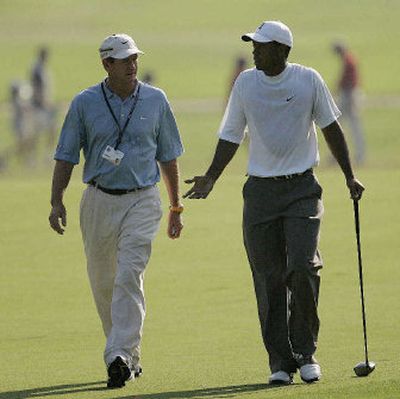No one in his footsteps

PINEHURST, N.C. – Ten years after he joined the PGA Tour, Tiger Woods still stands alone, and not just because he’s so good.
Woods was supposed to open the sport up to black children in America and throughout the world. Yet a decade later, he remains the only African-American on the tour. This week, he plays at the U.S. Open, being run by the USGA, which talks about bringing minorities into the sport but doesn’t have a single one on its executive committee.
“Am I disappointed? Yeah,” Woods said when asked about the dearth of blacks at the highest levels of golf. “I thought there would be more of us out here.”
Much of the recent debate about minorities in golf has centered on women, led by Martha Burk’s fight with Augusta National, the home of the Masters. Since June 2002, Burk has demanded that Augusta admit women, and the Masters responded by pulling ads from its telecasts for two years to protect corporate sponsors from protests. Ads were restored for this year’s telecast.
While many viewed that protest as more smoke than fire, the flare-up at Shoal Creek, home of the PGA Championship in 1990, was much more serious. The Alabama course didn’t allow blacks and the PGA was pressured into creating a policy of only taking its tournament to courses that were integrated.
Threatened with a boycott, Shoal Creek allowed a black to join before the tournament began. Despite that, there was no denying the episode tarnished golf and exposed it for what it pretty much was at the time – a country-club game, mainly white, mostly rich and not overly concerned with changing its image.
Woods’ arrival was supposed to change that. But 10 years later, Woods is the only African-American among the 156 contending for the U.S. championship. Vijay Singh, the other prominent player on the PGA tour with black skin, is Fijian.
Meanwhile, looking among the gallery Wednesday at Pinehurst No. 2, it would be a stretch to say things are truly integrated. In a state that is 21 percent black, there were maybe two black fans for every 100 white ones who roamed the grounds.
Among them were Ron Dechamps and his 12-year-old son – the father a once-a-month golfer and the son trying to play as much as he can.
“I think Tiger’s done a lot for the sport,” Dechamps said. “He’s put more focus and emphasis on getting African-Americans involved. But I think the PGA or the USGA could do more. There’s not enough emphasis on getting the grass roots involved.”
With much fanfare, the PGA Tour established the First Tee program eight years ago, an attempt to bring the game to the inner city and get more minorities involved. In many ways, the program has been a success. Of its 450,000 participants, 44 percent are white, 27 percent are black and 10 percent are Hispanic. In all of golf, 84 percent of the players are white.
While programs like First Tee offer scholarships and help set up courses where costs are low, golf is not a cheap sport to play. Greens fees are often expensive. Clubs can cost several hundred dollars. Good instruction – the kind that can turn good young players into top-notch amateurs – doesn’t come cheap. Nor does access to the kind of courses they need to get used to if they hope to move into the top ranks.
This is in stark contrast to basketball, played on playgrounds, or even tennis, where a racquet and a $3 can of balls can get a kid on the court.
“At the junior level there are some players with some talent,” Woods said. “But as you continue to play throughout golf and continue to move up in levels, the process of screening kind of weeds them out. It’s hard to make it out here.”
Woods has seen the numbers grow in his 10 years as a pro.
“But we don’t have a big enough base for them to have an opportunity to get out here,” he said.
Meanwhile, the USGA executive committee has had blacks before, but currently, there isn’t a single black person among its 15 volunteer members. Asked about that Wednesday, USGA president Fred Ridley pointed out the myriad ways the organization gets minorities involved – other committees, being the single-biggest contributor over the life of First Tee. But he conceded, “We have more to do.”
“Hopefully, some of the seeds we’re planting today will pay off and we’ll be happier on this issue in five, 10, 15, 20 years,” Ridley said.